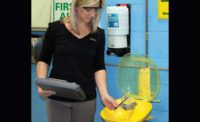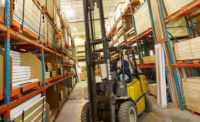
For more than 35 years, the ANSI/ISEA Z358.1 standard on emergency eyewash and shower equipment has been the authoritative document for equipment manufacturers, users, specifiers, installers and regulators. This standard specifies minimum performance criteria for flow rates, temperature, and drenching patterns of emergency showers, eyewash equipment, combination units and drench hosts — all characteristics that are important for a user to receive adequate rinsing of a contaminant in an emergency situation.
Equally important are the installation requirements and maintenance directives to ensure that the equipment is available in proper working condition should the need for the use of the equipment arise.
The eyewash and shower standard is developed by the Emergency Eyewash and Shower Group of the International Safety Equipment Association (ISEA) and approved as an American National Standard. The current edition was approved in September 2009, and designated ANSI/ISEA Z358.1-2009.
Conducting an assessment of workplace areas and potential harmful exposures and becoming familiar with the ANSI standard go hand-inhand toward mitigating damage to skin or eye tissue that has come into contact with hazardous contaminants.
Assessment factors
Several factors to consider include:Selection of equipment: A detailed assessment will ensure that the appropriate equipment is chosen for a given work environment where certain risk exposures are assumed. As an example, plumbed equipment may be suitable for a pharmaceutical manufacturing facility, where large quantities of caustic materials are present. However, a remote construction site may not have access to a limitless supply of flushing fluid, making a selfcontained, portable device ideal. Equipment manufacturers can prove to be a valuable resource to assist in evaluating the precise needs of the work area.
Appropriate temperatures for flushingfluid: While the type of flushing may vary depending on the device (potable water for plumbed units, solution of potable water and preservative or a sealed fluid cartridge), the temperature of the delivered fluid must be tepid, currently defined by the ANSI/ISEA Z358.1 standard as 60–100 degrees F. Tepid flushing fluid encourages the victim to rinse an affected tissue area without creating further discomfort.
Location and accessibility: It does little good to have emergency flushing equipment if it is not readily accessible to the injured worker requiring its use. For this reason, equipment must be situated in an area that takes no longer than 10 seconds to reach from the hazard. Obstacles in the path of travel must be eliminated and equipment needs to be installed in areas that are well lit and have visible signage identifying its location. Consideration must also be given to the presence of other potential hazards that may be adjacent to the path of travel that might cause additional injury, such as protruding wall fixtures in the area or the creation of slip hazards once the emergency equipment is activated.
Equipment maintenance and employee training: While it is hoped that emergency flushing equipment is not needed, it is crucial that it be maintained to ensure it is functional at all times. Plumbed equipment must be operated on a weekly basis. This frequency reduces the chance of sediment build-up and the growth of microbial hazards in stagnant water in the supply line. Manufacturer’s instructions are to be followed when maintaining self-contained units as these may vary given the specific configuration of the equipment. Finally, all potential users must be trained on the use of equipment and should be retrained periodically, particularly when there has been a change in the equipment provided or in the facility layout.
OSHA references
In the final rule for General Working Conditions for Shipyards, published on Monday, May 2, OSHA states that in work areas where it is impracticable to place permanent (plumbed) quick-drenching facilities, such as confined spaces, the employer would need to provide portable facilities. OSHA does not believe this requirement should pose a problem for employers since many employers already have these portable facilities. OSHA correctly notes in the final rule that the ANSI Z358.1 standard includes specifications for self-contained eyewash equipment, as well as personal quick-drenching.In addition, in an October 18, 2010, OSHA memo to the regional administrators, OSHA says that equipment compliant with the 2009 version of ANSI Z358.1, American National Standard for Emergency Eyewash and Shower Equipment provides “suitable” eyewash facilities for exposures to Portland cement.
A patchwork of cities and states also refer to and require the ANSI/ISEA Z358.1 standard. The International Code Commission Los Angeles’s Buildings and Safety Department requires compliance with many provisions of ANSI Z358.1
ISEA has received a number of calls where employers were cited for not providing suitable flushing and drenching facilities, and told to install a device that meets ANSI/ISEA Z358.1. Would it not have been more efficient and protective to require this standard in the first place? Based on this current situation, ISEA is developing a petition to ask OSHA to formally recognize this standard at 1910.151(c) and in the other corresponding sections of the construction and maritime standards.

